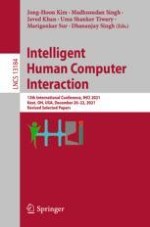2022 | Buch
Intelligent Human Computer Interaction
13th International Conference, IHCI 2021, Kent, OH, USA, December 20–22, 2021, Revised Selected Papers
herausgegeben von: Jong-Hoon Kim, Madhusudan Singh, Javed Khan, Prof. Uma Shanker Tiwary, Prof. Marigankar Sur, Dhananjay Singh
Verlag: Springer International Publishing
Buchreihe : Lecture Notes in Computer Science
